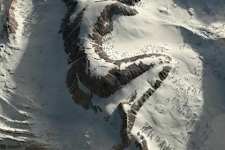It is one of the most iconic images ever captured of the cosmos, and with the help of the most advanced telescope ever sent into space, scientists have a better view of the star factory than ever before.
By Brian Lada, AccuWeather meteorologist and staff writer
Published Oct. 19, 2022 12:58 PM CDT | Updated Oct. 20, 2022 2:05 PM CDT
The Pillars of Creation became famous in 1995 after the Hubble Space Telescope captured images of the towering clouds of cosmic dust and gas located 6,500 light-years away from Earth. Nearly three decades after those images were shared, the celestial spectacle has been given new life by the most powerful telescope ever launched into space.
The James Webb Space Telescope recently used its highly advanced sensors to shed new light on the region of space where stars are being born.
"Newly formed stars are the scene-stealers in this image," said NASA, which released the new images on Wednesday. NASA officials added that the newest stars appear like red orbs compared to other stars in the image.

The Pillars of Creation are set off in a kaleidoscope of color in NASA’s James Webb Space Telescope’s near-infrared-light view. The pillars look like arches and spires rising out of a desert landscape but are filled with semi-transparent gas and dust and are ever-changing. (NASA, ESA, CSA, STScI; Joseph DePasquale (STScI), Anton M. Koekemoer (STScI), Alyssa Pagan (STScI)
The power of the JWST has provided scientists with a more detailed view of the iconic pillars when compared to the image captured by the Hubble Space Telescope 27 years ago.
"Webb’s new look identifies far more precise counts of newborn stars, along with the quantities of gas and dust," NASA said. "This will help us build a clearer understanding of how stars form and burst out of these dusty clouds over millions of years."
Some of the pillars are about five light-years tall, meaning that if a spaceship could travel at the speed of light, it would take five years to travel the length of the pillars.
By taking observations of the Pillars of Creation throughout the decades, scientists will learn how stars come to life from the massive stellar nursery.
"Each advanced instrument offers researchers new details about this region, which is practically overflowing with stars," NASA said.
Some of the stars in the new image are not even 1 million years old, according to NASA.

NASA's Hubble Space Telescope made the Pillars of Creation famous with its first image in 1995 (left). A new, near-infrared-light view from NASA’s James Webb Space Telescope, at right, helps us peer through more of the dust in this star-forming region (right). (NASA, ESA, CSA, STScI; Joseph DePasquale (STScI), Anton M. Koekemoer (STScI), Alyssa Pagan (STScI))
This is not the first time that the JWST and the Hubble teamed up to take observations of a star factory.
In September, NASA unveiled an image of the Tarantula Nebula, the largest and brightest star-forming region in the galactic neighborhood. It is estimated to be around 340 light-years across, making it significantly larger than the Pillars of Creation.
"Hubble and Webb will work together to showcase the universe across multiple wavelengths of light," NASA said. "Two space telescopes, twice the star power."
More Space and Astronomy:
Want next-level safety, ad-free? Unlock advanced, hyperlocal severe weather alerts when you subscribe to Premium+ on the AccuWeather app. AccuWeather Alerts™ are prompted by our expert meteorologists who monitor and analyze dangerous weather risks 24/7 to keep you and your family safer.
![Generate Free Power with This Weird Backyard Device [WATCH]](https://images.revcontent.com/revcontent/image/fetch/f_jpg,q_auto,h_150,w_225,c_fill,g_face:auto/pg_1/https://media.revcontent.com/content/images/63501f4bc690c2-34532557.png)







No comments:
Post a Comment